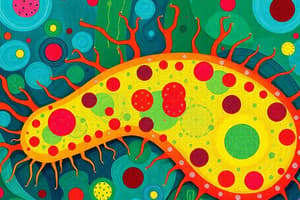Podcast
Questions and Answers
What distinguishes the cell wall structure of Euglena viridis?
What distinguishes the cell wall structure of Euglena viridis?
- It has a rigid cell wall made of cellulose.
- It lacks a cell wall and has a flexible pellicle. (correct)
- It has a thick, chitinous cell wall.
- It possesses a cell wall mainly composed of proteins.
In which environments is Euglena viridis most commonly found?
In which environments is Euglena viridis most commonly found?
- Deserts and arid regions.
- Saltwater oceans and estuaries.
- High-altitude regions with low temperatures.
- Freshwater environments such as ponds and lakes. (correct)
What type of reproduction is primarily used by Euglena viridis?
What type of reproduction is primarily used by Euglena viridis?
- Budding off new organisms.
- Sexual reproduction through gamete fusion.
- Fragmentation of the parent organism.
- Asexual reproduction through binary fission. (correct)
How does Euglena viridis contribute to nutrient cycling in ecosystems?
How does Euglena viridis contribute to nutrient cycling in ecosystems?
What role does the eyespot (stigma) play in Euglena viridis?
What role does the eyespot (stigma) play in Euglena viridis?
Flashcards are hidden until you start studying
Study Notes
Euglena viridis Study Notes
Cell Structure
- Shape: Elongated, spindle-shaped cell.
- Cell Wall: Lacks a rigid cell wall; instead, has a flexible pellicle.
- Chloroplasts: Contains chloroplasts for photosynthesis; green due to chlorophyll.
- Flagellum: Equipped with a single anterior flagellum for movement.
- Eyespot: Possesses a stigma (eyespot) that detects light, aiding in phototaxis.
- Organelles: Contains a nucleus, contractile vacuoles for osmoregulation, and lipid droplets.
Habitat and Distribution
- Habitat: Prefers freshwater environments, often found in ponds, lakes, and marshes.
- Distribution: Widely distributed globally; thrives in warm, nutrient-rich waters.
- Adaptations: Can tolerate varying conditions, including changes in light and nutrient availability.
Life Cycle
- Reproduction: Primarily asexual reproduction through binary fission.
- Cyst Formation: Under unfavorable conditions, can form cysts to survive in dormant state.
- Motility: The flagellum aids in mobility, allowing the organism to move toward light or favorable conditions.
Photosynthesis
- Chlorophyll: Contains chlorophyll a and b, enabling it to capture light energy.
- Light Reaction: Utilizes sunlight to convert carbon dioxide and water into glucose and oxygen.
- Mixotrophy: Capable of heterotrophic nutrition by absorbing organic material when light is insufficient.
Role in Ecosystems
- Primary Producer: Acts as a primary producer in aquatic ecosystems, forming the base of the food web.
- Nutrient Cycling: Contributes to the cycling of nutrients in freshwater habitats.
- Indicator Species: Serves as an indicator of water quality due to its sensitivity to environmental changes.
- Symbiotic Relationships: Can engage in symbiotic relationships with other organisms, aiding in nutrient exchange.
Cell Structure
- Elongated and spindle-shaped, optimizing movement and feeding efficiency.
- Lacks a rigid cell wall, featuring a flexible pellicle that allows shape changes.
- Contains chloroplasts rich in chlorophyll, enabling photosynthesis and giving its green color.
- Equipped with a single anterior flagellum, which aids in locomotion through aquatic environments.
- Features a stigma (eyespot) for detecting light, facilitating movement towards favorable conditions (phototaxis).
- Has essential organelles like a nucleus and contractile vacuoles for osmoregulation, along with lipid droplets for energy storage.
Habitat and Distribution
- Thrives in freshwater environments such as ponds, lakes, and marshes where sunlight penetrates.
- Seen globally, particularly in warm, nutrient-rich waters ideal for growth.
- Demonstrates adaptability to varied conditions, including fluctuations in light and nutrient availability, enhancing survival.
Life Cycle
- Reproduces primarily through binary fission, a form of asexual reproduction that allows rapid population increase.
- Under adverse conditions, forms cysts, enabling it to enter a dormant state for survival until conditions improve.
- Utilizes its flagellum for motility, moving towards light or other favorable environmental conditions to optimize photosynthesis.
Photosynthesis
- Contains chlorophyll a and b, optimizing light absorption for energy conversion.
- Conducts light reactions to transform sunlight, carbon dioxide, and water into glucose (energy) and oxygen (byproduct).
- Exhibits mixotrophic behavior, allowing it to absorb organic materials in the absence of light, thus harnessing energy from multiple sources.
Role in Ecosystems
- Functions as a primary producer in aquatic ecosystems, forming a foundational component of the food web.
- Plays a vital role in nutrient cycling within freshwater habitats, supporting the overall ecosystem health.
- Acts as an indicator species to monitor water quality due to its sensitivity to environmental shifts.
- Engages in symbiotic relationships with various organisms, promoting nutrient exchange and mutual benefits.
Studying That Suits You
Use AI to generate personalized quizzes and flashcards to suit your learning preferences.




